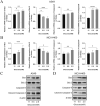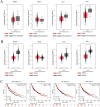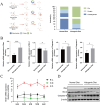The Pro-Apoptotic Effect of Glucose Restriction in NSCLC via AMPK-Regulated Circadian Clock Gene Bmal1
- PMID: 40394734
- PMCID: PMC12317398
- DOI: 10.1111/cas.70098
The Pro-Apoptotic Effect of Glucose Restriction in NSCLC via AMPK-Regulated Circadian Clock Gene Bmal1
Abstract
The circadian clock is a crucial regulator of mammalian physiology, controlling daily oscillations in key biological processes, such as cell proliferation, apoptosis, and DNA damage repair. Disruption of circadian rhythms has been identified as a significant risk factor for cancer development and progression, yet the specific molecular mechanisms linking circadian dysfunction to cancer remain poorly understood. Recent studies have increasingly focused on the role of diet in modulating circadian rhythms, highlighting the potential for dietary interventions in cancer management. However, how dietary factors like glucose restriction interact with circadian rhythms to influence cancer cell behavior remains an open question. Here, we investigate the mechanisms underlying glucose restriction-induced apoptosis in non-small cell lung cancer (NSCLC) cells, with a focus on the role of circadian clock genes. Analysis of the GEPIA database revealed that the circadian gene Bmal1 is highly expressed in normal tissues and associated with better prognosis in lung adenocarcinoma patients. In NSCLC cells, Bmal1 expression correlated with proapoptotic gene activity. In a tumor xenograft model using severe combined immunodeficiency (SCID) mice, a glucose-restricted (ketogenic) diet significantly delayed tumor growth and increased the expression of Bmal1 and proapoptotic genes. These findings suggest that glucose restriction promotes apoptosis in NSCLC cells through a Bmal1-mediated pathway, providing novel insights into the intersection between circadian regulation and cancer biology. Targeting core circadian clock genes like Bmal1 may represent a promising therapeutic strategy for managing lung cancer, broadening our understanding of how circadian rhythms can be harnessed for cancer prevention and treatment.
Keywords: AMPK; Bmal1; NSCLC; apoptosis; glucose restriction.
© 2025 The Author(s). Cancer Science published by John Wiley & Sons Australia, Ltd on behalf of Japanese Cancer Association.
Conflict of interest statement
The authors declare no conflicts of interest.
Figures





Similar articles
-
Sex differences in the adrenal circadian clock: a role for BMAL1 in the regulation of urinary aldosterone excretion and renal electrolyte balance in mice.Am J Physiol Renal Physiol. 2025 Jan 1;328(1):F1-F14. doi: 10.1152/ajprenal.00177.2024. Epub 2024 Oct 24. Am J Physiol Renal Physiol. 2025. PMID: 39447118 Free PMC article.
-
Integrin αVβ1-activated PYK2 promotes the progression of non-small-cell lung cancer via the STAT3-VGF axis.Cell Commun Signal. 2024 Jun 6;22(1):313. doi: 10.1186/s12964-024-01639-1. Cell Commun Signal. 2024. PMID: 38844957 Free PMC article.
-
Circadian control of hepatic ischemia/reperfusion injury via HSD17B13-mediated autophagy in hepatocytes.J Hepatol. 2025 Sep;83(3):750-767. doi: 10.1016/j.jhep.2025.02.029. Epub 2025 Mar 4. J Hepatol. 2025. PMID: 40049242
-
PET-CT for assessing mediastinal lymph node involvement in patients with suspected resectable non-small cell lung cancer.Cochrane Database Syst Rev. 2014 Nov 13;2014(11):CD009519. doi: 10.1002/14651858.CD009519.pub2. Cochrane Database Syst Rev. 2014. PMID: 25393718 Free PMC article.
-
The Black Book of Psychotropic Dosing and Monitoring.Psychopharmacol Bull. 2024 Jul 8;54(3):8-59. Psychopharmacol Bull. 2024. PMID: 38993656 Free PMC article. Review.
References
-
- Kratzer T. B., Bandi P., Freedman N. D., et al., “Lung Cancer Statistics, 2023,” Cancer 130 (2024): 1330–1348. - PubMed
-
- Li Y., Yan B., and He S., “Advances and Challenges in the Treatment of Lung Cancer,” Biomedicine & Pharmacotherapy 169 (2023): 115891. - PubMed
-
- Hirsch F. R., Scagliotti G. V., Mulshine J. L., et al., “Lung Cancer: Current Therapies and New Targeted Treatments,” Lancet 389 (2017): 299–311. - PubMed
MeSH terms
Substances
Grants and funding
LinkOut - more resources
Full Text Sources
Medical

